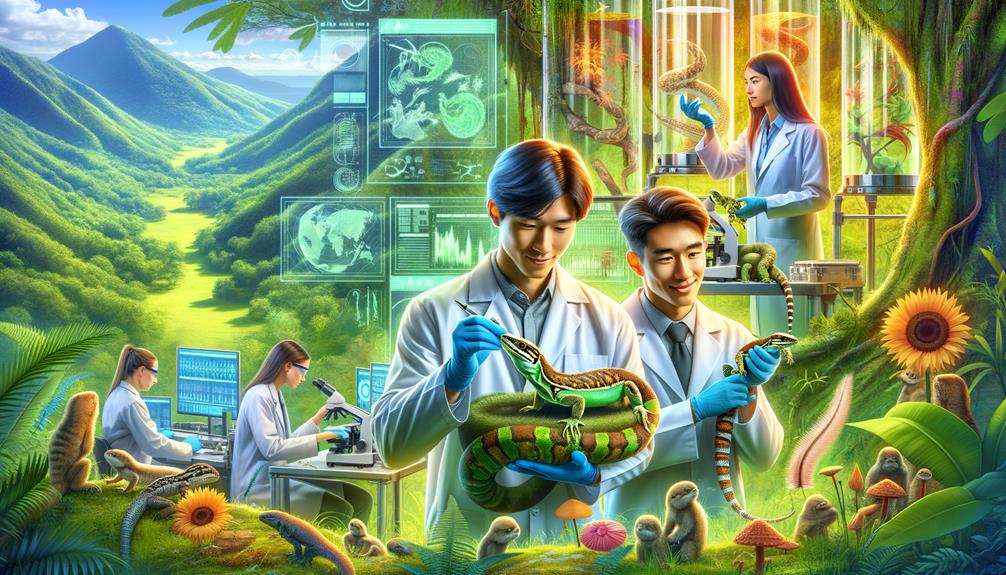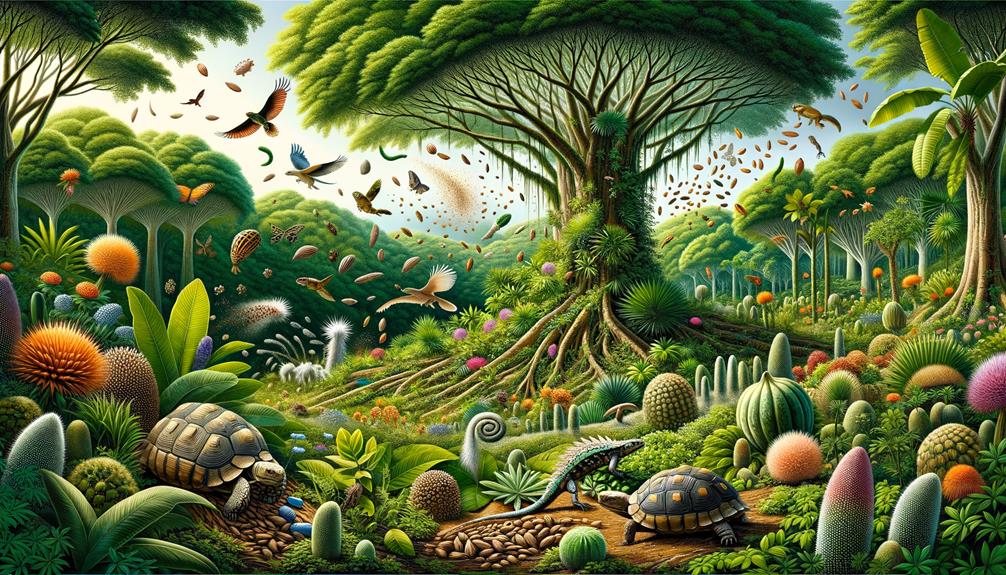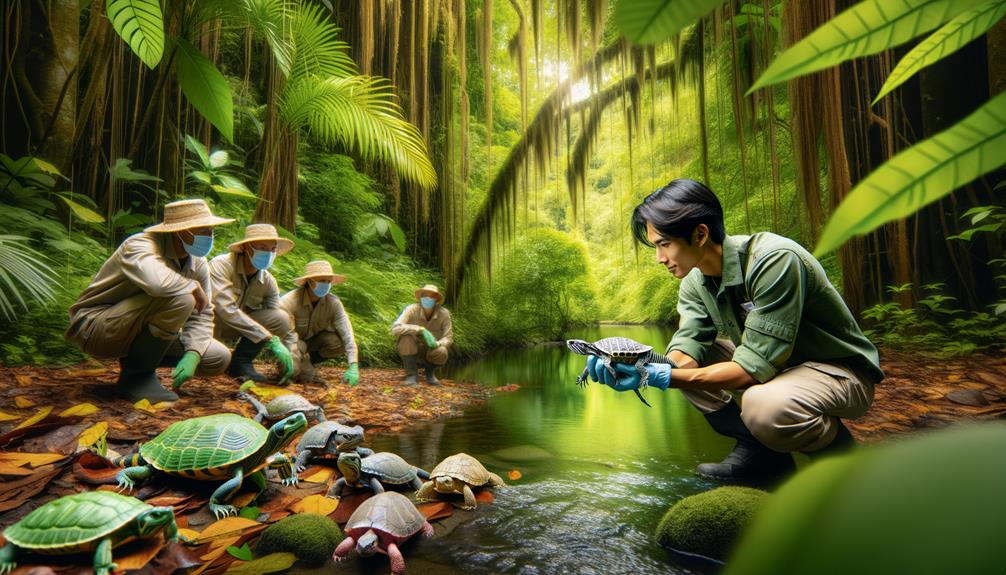I've had the privilege of witnessing remarkable successes in reptile reintroduction projects. The return of Galapagos land iguanas on Santiago Island, for instance, has restored the ecological balance. Similarly, efforts on Espanola Island have increased the giant tortoise population from a mere 15 to over 1,000. As ecosystem engineers, these reptiles play a vital role in controlling vegetation and dispersing seeds. Their successful reintroduction has not only been cost-effective and efficient but has also set a precedent for future initiatives. What's more, these projects don't just save species – they regenerate entire habitats. Would you like to know more about how these reptiles drive ecological restoration?
Key Takeaways
Reintroduction of Galapagos land iguanas to Santiago Island has brought the species back from the brink and restored ecological balance.
The Espanola giant tortoise population has experienced a remarkable surge, growing from just 15 individuals to over 1,000, thanks to successful breeding and reintroduction programs.
By dispersing seeds and grazing, tortoises have facilitated the recovery and spread of endemic plant species.
Galapagos tortoises' natural behaviors play a significant role in habitat restoration and biodiversity.
Reptile reintroduction projects have proven to be cost-effective and scalable strategies for conservation and ecosystem engineering, offering a promising approach for species preservation.
Galapagos Land Iguanas
The reintroduction of Galapagos land iguanas to Santiago Island has not only revived a species but also restored ecological balance. As I observed these resilient creatures, I was struck by how quickly they adapted to their native habitat. This species reintroduction effort, which began with rigorous captive breeding programs, has seen the population soar past 5,000 individuals.
The breeding programs were meticulously designed to ensure genetic diversity and health, setting a strong foundation for reintroduction. Seeing the iguanas breed sustainably in the wild is a testament to the program's success. They play a vital role as herbivores, helping maintain the island's vegetation by controlling certain plant populations. This natural pruning allows a variety of flora to flourish, fostering a balanced ecosystem.
Monitoring data confirms that these iguanas are thriving. It's heartening to witness a clear example of how well-planned conservation efforts can make a significant impact. The Galapagos land iguana reintroduction project serves as a model for similar initiatives worldwide, demonstrating that with dedication and strategic planning, we can restore not only species but also the delicate balance of nature they inhabit.
Espanola Giant Tortoises

I'm thrilled to share the amazing comeback story of the Espanola giant tortoises. Conservation efforts and a successful breeding program have helped their population surge from just 15 individuals to over 1,000. By reintroducing these tortoises, not only have their numbers grown, but the island's ecosystem has also flourished, highlighting the significant impact of habitat restoration.
Population Recovery Efforts
Against all odds, the reintroduction of Espanola giant tortoises has achieved a stunning turnaround, showcasing a remarkable example of successful conservation efforts. Decades ago, habitat loss pushed them to the brink of extinction, leaving only 15 individuals on Espanola Island. Today, over 1,000 tortoises roam freely, thanks to dedicated reintroduction projects.
The restoration of these gentle giants didn't happen overnight. It required a collaborative effort from the Galapagos National Park and the Galapagos Conservancy, focusing on:
- Breeding programs in captivity: Ensuring genetic diversity and the survival of hatchlings.
- Reintroduction initiatives: Transporting tortoises back to their native island to reinforce the population.
- Ecosystem restoration: Reviving the island's vegetation, essential for long-term sustainability.
These initiatives have not only revived the Espanola giant tortoise population but also revitalized the island's ecosystem. Tortoises play a crucial role in dispersing seeds and maintaining vegetation balance. Monitoring data reveals a promising annual growth rate of 4-5%, underscoring the effectiveness of these long-term efforts.
This remarkable conservation success story sets a hopeful precedent for the conservation of other endangered species. The journey of the Espanola giant tortoises illustrates the power of persistent dedication and strategic intervention in overcoming the dire consequences of habitat loss.
Breeding Program Success
The Espanola giant tortoise breeding program is a shining example of conservation success. In the 1970s, there were just 12 individuals left, but thanks to the Galapagos National Park's initiative, the population has grown to over 1,000 tortoises.
The dedication to reptiles and amphibians in this program is truly inspiring. Breeding pairs were carefully selected to maximize genetic diversity and ensure the long-term health of the population. Once reintroduced to their native Espanola Island, the tortoises adapted seamlessly to their environment, proving the program's effectiveness. Today, the population on Espanola Island is stable and self-sustaining.
Ongoing monitoring and management continue to protect these magnificent creatures, ensuring the Espanola giant tortoise remains a symbol of conservation triumph. This success story highlights the potential of well-executed breeding programs to save critically endangered species and restore ecological balance.
Habitat Restoration Impact
The reintroduction of Espanola giant tortoises to their native island has led to a significant recovery of endemic plant species, highlighting their crucial role as ecosystem engineers. By bringing back these herbivorous reptiles, we've witnessed a remarkable turnaround in the island's native vegetation, which was once severely threatened by invasive goats. The tortoises' browsing and grazing activities have enabled native plants, including the endangered Espanola daisy (Darwiniothamnus tenuifolius), to reclaim their territory.
Grazing and Browsing: The tortoises feed on invasive plant species, allowing native flora to thrive.
Seed Dispersal: As tortoises move across the island, they disperse seeds, facilitating the germination and spread of endemic plants.
Soil Aeration: Through their movement and foraging activities, tortoises naturally till the soil, promoting healthier plant growth.
Monitoring data confirms that these tortoises have established self-sustaining, breeding colonies, which are part of a broader effort to restore the island's ecosystem. This success story demonstrates how herbivorous reptiles like the Espanola giant tortoises can effectively drive ecological restoration and rewilding initiatives. Their impact offers hope for conservation efforts worldwide.
Ecosystem Engineering Impact

Herbivorous reptiles like the Galapagos and Aldabra giant tortoises are ecosystem engineers, greatly influencing habitat restoration and biodiversity through their natural behaviors. By grazing, browsing, and trampling, these tortoises actively shape their environments, aiding the dispersal of endangered plant species and altering environmental conditions to foster self-sustaining ecosystems.
Their impact is significant. For example, Galapagos tortoises help spread seeds of endangered plants, ensuring these species continue to thrive. On various islands, reintroduced Aldabra giant tortoises have rejuvenated ecosystem functions, contributing to the recovery of native flora.
| Behavior | Ecological Impact |
|---|---|
| Grazing | Suppresses invasive plant species |
| Browsing | Encourages diverse plant communities |
| Trampling | Creates pathways, facilitating seed dispersal |
| Seed Dispersal | Boosts genetic diversity of plant species |
| Movement Patterns | Maintains dynamic, balanced ecosystems |
These tortoises demonstrate the power of ecosystem engineering. Their natural activities not only modify the landscape but also create conditions where other species can flourish, making them invaluable assets in rewilding projects. Their ability to initiate and sustain natural processes through their foraging and movement patterns underscores their critical role in conservation efforts.
In essence, these tortoises are crucial for restoring and maintaining healthy ecosystems. By allowing them to thrive in their natural habitats, we can create a ripple effect that benefits numerous species and promotes ecological balance.
Cost-Effectiveness and Logistics

When it comes to budget allocation strategies, reptile reintroduction projects stand out for their cost-effectiveness. This is largely due to the simpler care and slower reproduction rates of reptiles. Compared to mammals, transporting reptiles and setting up suitable habitats is generally more straightforward and less costly, making logistical planning easier. Additionally, reptile rewilding efforts often face less political and social resistance, which further simplifies these conservation initiatives.
Budget Allocation Strategies
In allocating budgets for conservation, reptile reintroduction projects offer a cost-effective and logistically simpler alternative to large mammal programs. The ultimate goal is to restore functional ecosystems, and reptiles can play a key role in this. With simpler husbandry requirements and slower reproductive rates, they require less financial investment. Additionally, reptiles face fewer social and political hurdles, smoothing the path for successful rewilding.
Reptile reintroduction projects have several benefits, including:
- Cost savings: Lower husbandry costs and fewer resources needed for monitoring.
- Easier management: Simpler population management and manipulation due to less complex social dynamics.
- Less opposition: Fewer political and social obstacles compared to large mammal reintroduction.
Successful initiatives, such as the reintroduction of Galapagos land iguanas and Aldabra giant tortoises, demonstrate the feasibility and effectiveness of these programs. By allocating more funds and scientific focus to reptile conservation, we can uncover new opportunities for rewilding efforts. This strategy aligns with fiscal prudence and paves the way for more resilient ecosystems.
Transportation and Habitat Setup
Transporting and setting up habitats for reptile reintroduction projects is remarkably cost-effective and logistically efficient. We use specialized equipment like insulated containers and temperature-controlled vehicles to ensure the reptiles' safe handling. Once they arrive at the release site, on-site acclimation enclosures help them adjust smoothly.
Reptiles have minimal housing requirements, making it feasible to establish pre-release captive facilities that can hold larger numbers of individuals. This cost-effectiveness allows us to allocate resources toward other important aspects of conservation.
Careful habitat selection and preparation are crucial to the success of these projects. By planting native vegetation and constructing refuges, we create environments that support the reptiles' natural behaviors and improve their post-release survival rates. Ensuring a reliable food source within these habitats further enhances their chances of thriving.
Logistically, reptile reintroductions are simpler to manage. The transportation and housing processes are easier to organize, making it possible to scale up projects efficiently to meet population targets. This efficiency makes these efforts financially viable and enables us to achieve significant conservation milestones.
Plant Dispersal Benefits

Galapagos tortoises, through their natural grazing and browsing behaviors, have greatly boosted the dispersal of endangered plant species, aiding essential ecosystem restoration efforts. These gentle giants act as ecosystem engineers, profoundly impacting plant communities and habitat structures. By reintroducing herbivorous reptiles like the Galapagos tortoises, we're witnessing a fascinating ripple effect where plant species thrive and ecosystems regain balance.
In addition to tortoises, lizard reintroduction projects have also shown promise. These herbivorous reptiles create favorable conditions for plant growth through their foraging activities, consequently facilitating the establishment of endangered plant species.
Tortoises and lizards ingest seeds, which then germinate in new locations through their droppings, allowing seed dispersal to occur. Their grazing patterns help control invasive plant species, allowing native flora to flourish, effectively structuring habitats. The decomposition of their waste enriches the soil, promoting robust plant growth through nutrient cycling.
These successful reptile rewilding projects highlight how essential herbivorous reptiles are in boosting plant dispersal and establishing endangered species. It's a testament to the intricate dance of nature, where every creature plays a pivotal role in conserving our planet.
Future of Reptile Rewilding

Building on past successes in reintroduction projects, we need to explore the future of reptile rewilding to ensure these ecosystem engineers continue to thrive and restore balance in their native habitats. Scientific focus and funding are crucial to expand our efforts beyond large mammals. Herbivorous reptiles, such as Galapagos land iguanas and Aldabra giant tortoises, have already shown their potential to restore self-sustaining ecosystems by acting as keystone species.
To optimize rewilding strategies, we need a holistic, ecosystem-level conservation approach that considers reptiles and amphibians. This will ensure more inclusive and effective outcomes. These creatures play critical roles in their environments, from seed dispersal to controlling insect populations, which highlights their importance in maintaining ecological balance.
Our ongoing research and monitoring efforts are vital in refining rewilding strategies. By understanding the long-term impacts of these initiatives, we can better prepare for future projects and guarantee their success. Going forward, including reptiles in conservation dialogues and actions will be critical. We need to recognize the importance of these species and work towards thriving, balanced ecosystems where all species can coexist harmoniously.
Frequently Asked Questions
What Is the Success Rate of Species Reintroduction?
Success rates for species reintroduction vary widely, ranging from impressive highs to disheartening lows. On average, a mere 15% of reintroduction efforts achieve full success in establishing self-sustaining populations. To boost the chances of success, thorough research, habitat assessment, and ongoing monitoring are crucial.
What Are the Success Stories of Captive Breeding Programs?
Captive breeding programs have achieved remarkable success stories. The recovery of species like the Anegada rock iguana, Antiguan racer, Jamaican iguana, Grand Cayman iguana, and Cuban crocodile from the brink of extinction is a testament to the power of conservation efforts.
Why Are Reintroduction Programs Important?
Reintroduction programs are vital for preserving endangered reptile populations and their habitats. By restoring these species, we maintain ecosystem balance and garner public support for conservation efforts. Losing these species would have devastating consequences.
How Can Reintroduction Programs Help Endangered Species?
Reintroduction programs can breathe new life into endangered species by rebuilding their populations through controlled breeding. By doing so, they restore the delicate balance of ecosystems and ensure the long-term survival of these species. Effective management and monitoring are crucial for a successful reintroduction and maintaining a healthy ecosystem.



